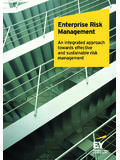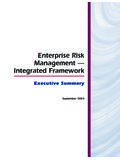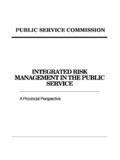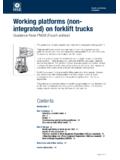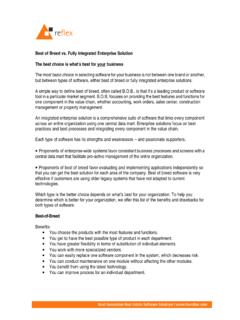Transcription of An integrated vision to manage cyber risk - EY
1 an integrated vision to manage cyber risk Why cybersecurity is everyone's responsibility in today's financial services organization Contents Introduction 3. The need for an integrated cybersecurity vision 4. Priority one: talent-centric making employees cybersecurity smart 6. Priority two: strategic and innovative integrating cybersecurity within the organization 8. Priority three: risk focused prioritizing what's critical 12. Priority four: intelligent and agile protecting what's critical 16. Priority five: resilient and scalable bouncing back and protecting the ecosystem 18. 10 things to do right now 20. Conclusion 22. How we can help 23. Contacts 23. 2 an integrated vision to manage cyber risk Introduction Today's cyber attacks are becoming more numerous, more frequent and existentially more threatening than ever before.
2 The new generation of attackers are no longer always motivated simply by stealing funds and holding companies' information hostage. Instead, their aim can be to infiltrate and manipulate not just an individual company but the entire ecosystem to which it belongs. cyber risks are heightened as financial institutions transform their operations via new digital channels, automation and other advanced technologies. This is in addition to open banking beginning to reshape the sector's approach to data sharing. Financial services companies continue to devote significant investments in securing gaps in their Jeremy Pizzala internal, online and digital frameworks, as those who EY Global FS Cybersecurity want to exploit the weaknesses are getting smarter, Lead bolder and more destructive.
3 In response, regulators are heavily focused on managing systemic cyber risk and potential contagion across organizations and third parties. The new cyber threats pose serious questions about organizations' preparedness to rebound from a breach less than 14% of respondents to EY's latest Global Information Security Survey (GISS)1 think their information security function fully meets their organizational needs. In order for confidence to grow, cybersecurity must become every employee's responsibility as it extends across an organization's customer, supplier and vendor ecosystem. Contemporary cybersecurity extends beyond protecting sensitive information and systems from malicious external attack, into guarding identities, data privacy and vulnerability management on a vast scale.
4 For individual businesses, a new strategy for addressing cybersecurity is clearly needed. What we at EY call for is an integrated cybersecurity risk management approach that encompasses the resources and activities of the entire organization. 1 Path to cyber resilience: Sense, resist, react - EY's 19th Global Information Security Survey 2016-17, an integrated vision to manage cyber risk 3. The need for an integrated cybersecurity vision At their core, all financial services are based on This is no easy task but is achievable if companies trust. To win and maintain the trust of customers, prioritize the following five areas: financial institutions have to demonstrate consistent dedication to preserving confidentiality, confirming the availability of systems and services, and 1.
5 Talent centricity maintaining the integrity of data. As such, cyber Build a culture that makes cybersecurity attacks pose an unprecedented and existential part of everyone's job and create a chief threat to the sector. information security officer (CISO) role that is Putting cybersecurity at the heart of business fit for the purpose of your organization. strategy will help the financial services sector 2. Strategy and innovation maintain and even enhance the trust of consumers, Put cybersecurity at the heart of business regulators and the media. For a start, the C-suite strategy and ensure that new digital innovation can no longer assume that cybersecurity is solely includes cybersecurity at the outset.
6 The responsibility of the information security (IS) or information technology (IT) departments. 3. Risk focus Instead, financial services companies must make Understand broad trends and new cybersecurity a core part of business strategy and regulations that will impact how cyber culture. In doing so, they can enable the whole risk governance needs to evolve. organization to understand the risks they face, Implement a three-lines-of-defense (3 LoD). embrace the innovation needed to counter those approach with clearly defined roles and risks , and have the resilience to regroup and restore responsibilities to manage cyber risk operations smoothly and efficiently in the wake of a effectively.
7 cyber breach. 4. Intelligence and agility Companies need an integrated cybersecurity vision Develop internal knowledge capabilities to one that brings together the various functions and use contemporary insights and information dependencies with other parts of the organization, to assess the greatest cybersecurity threats. external key stakeholders and third-party suppliers. Deliver timely threat identification with a sharp focus on protecting the critical assets of the organization. 5. Resilience and scalability Be prepared to recover rapidly from a cyber breach while holding your ecosystem to the same cybersecurity standards that you follow as an organization. These five priorities will help financial services companies develop a cyber -secure and aware business culture that will protect the company, offer competitive advantage in the marketplace and help to solidify trust in the sector.
8 4 an integrated vision to manage cyber risk Figure 1: An integrated cybersecurity vision The pace of change in today's increasingly digitized world has led to the convergence of different risk disciplines that complement each other to address our clients' needs and those of their customers, regulators and business partners. Trust = con dentiality + availability + integrity Secure engagement Robust growth Business Regulatory Supporting Increased brand with customers agenda objectives compliance innovation protection and trust 5 Resilient and scalable 2 Strategic and innovative Helps minimize the impact of Embedded in strategic decision- disruptions and keeps pace making and adopts to, and bene ts with business growth: from, ongoing innovation: Incident response Strategy linked cyber crisis management M&A due diligence Resiliency and continuity Digital transformation Capital and liquidity management Robotics process automation (RPA).
9 Recovery and resolution FinTech, blockchain and 1 distributed ledger New product development Talent-centric Innovation and ideation Built on a foundation that makes cybersecurity everyone's responsibility: Talent management Board and 3 LoD. roles and responsibilities 4 3. Risk and security culture Intelligent Training and awareness Risk and agile focused Situationally aware and Driven by well-governed intelligence-driven risk alignment, risk awareness cybersecurity function that and risk prioritization: enables timely threat identi cation and response: cyber threat intelligence Governance Threat and vulnerability cyber risk management management and appetite Identity and access Policies and standards management Metrics and reporting Security operations and Third-party risk management (TPRM).
10 Managed services Regulatory awareness Technology architecture Increased Improved regulatory Business Effective risk Enhanced shareholder value alignment outcomes management branding Figure 1 source: Who are the typical cybersecurity stakeholders EY model, 2017. an integrated vision to manage cyber risk 5. Priority one Talent-centric making employees cybersecurity smart EY's GISS found that of executives see employees as posing the biggest internal cybersecurity vulnerability they are typically the people who click of executives see employees on a link and cause the problem to occur but the as posing the biggest internal reality is that it's becoming ever harder to differentiate legitimate from illegitimate information sources.










